AUDI S3 2016 Owners Manual
Manufacturer: AUDI, Model Year: 2016, Model line: S3, Model: AUDI S3 2016Pages: 328, PDF Size: 81.78 MB
Page 261 of 328
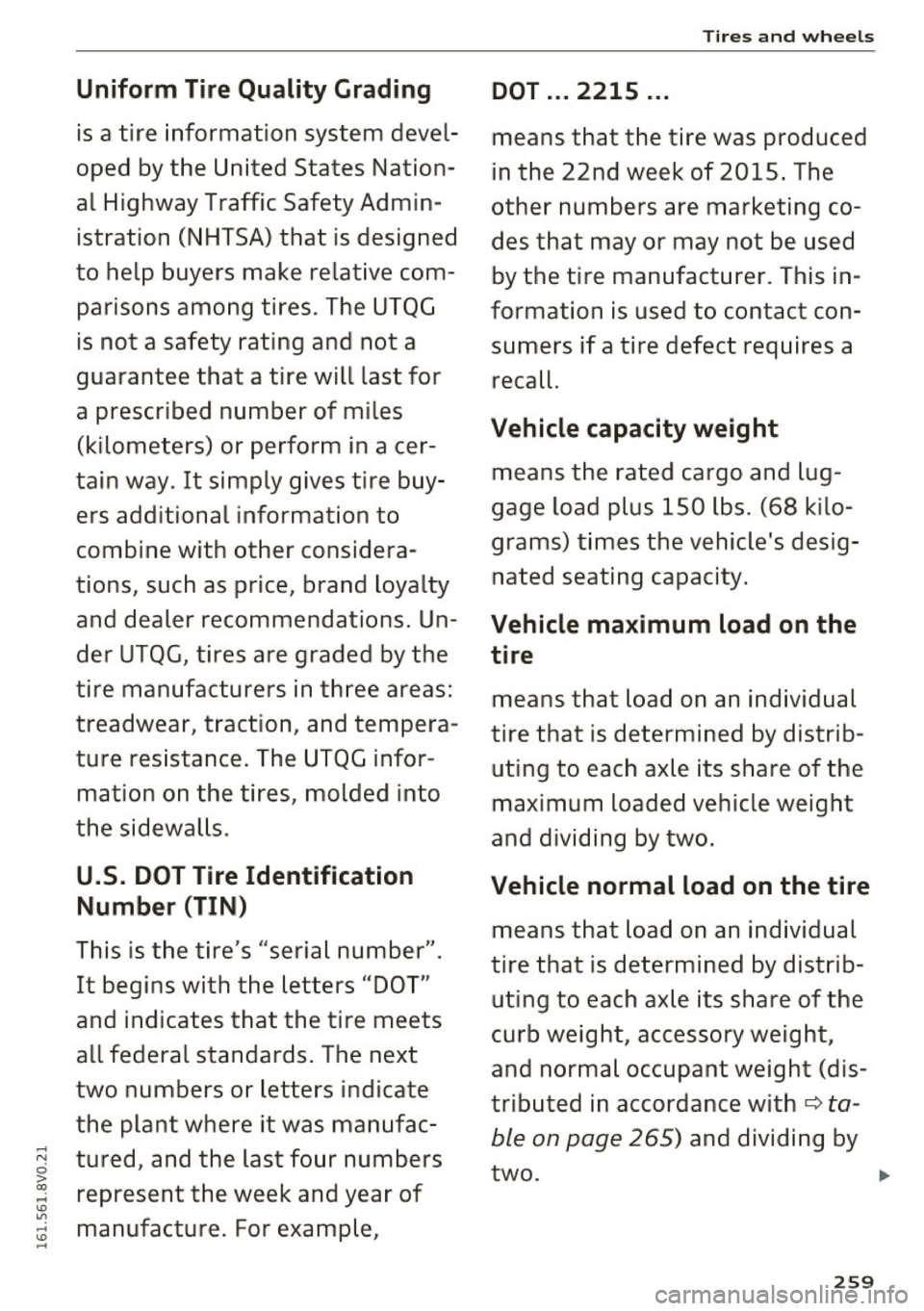
Uniform Tire Quality Gr ading
is a tire information system devel
oped by the United States Nation
al Highway Traffic Safety Admin
istration (NHTSA) that is designed
to help buyers make relat ive com
parisons among tires. The UTQG
is not a safety rating and not a
guarantee that a tire will last for
a prescribed number of miles
(kilometers) or perform in acer
tain way. It simply gives t ire buy
ers additional information to
combine with other considera
tions, such as price, brand loyalty
and dealer recommendations . Un
der
UTQG, tires are graded by the
tire manufacturers in th ree areas:
treadwear, traction, and tempera
ture resistance. The UTQG infor
mation on the tires, molded into
the sidewalls .
U.S. DOT Tire Identification
Number (TIN )
This is the tire's "serial number".
It begins with the letters "DOT"
and indicates that the tire meets
all federal standards . The next
two numbers or letters indicate
the plant where it was manufac
tured, and the last four numbers represent the week and year of
manufacture. For example,
Tires and wheels
DOT ... 2215 ...
means that the tire was produced
in the 22nd week of 2015. The
other numbers are marketing co des that may or may not be used
by the t ire manufacturer. This in
formation is used to contact con
sumers if a tire defect requires a
recall.
Vehicle capacity weight
means the rated cargo and lug
gage load plus 150 lbs . (68 k ilo
grams) times the vehicle's desig
nated seating capacity.
Vehicle ma ximum load on the
tire
means that load on an indiv idual
tire that is determined by distrib
ut ing to each axle its share of the
maximum loaded vehicle weight
and dividing by two.
Vehicle normal load on the tire
means that load on an individual
tire that is determined by dist rib
uting to each ax le its share of the
curb weight, accessory weight,
and normal occupant weigh t (dis
tributed in accordance with
c:::> ta
ble on page 265) and dividing by
two. .,.
259
Page 262 of 328
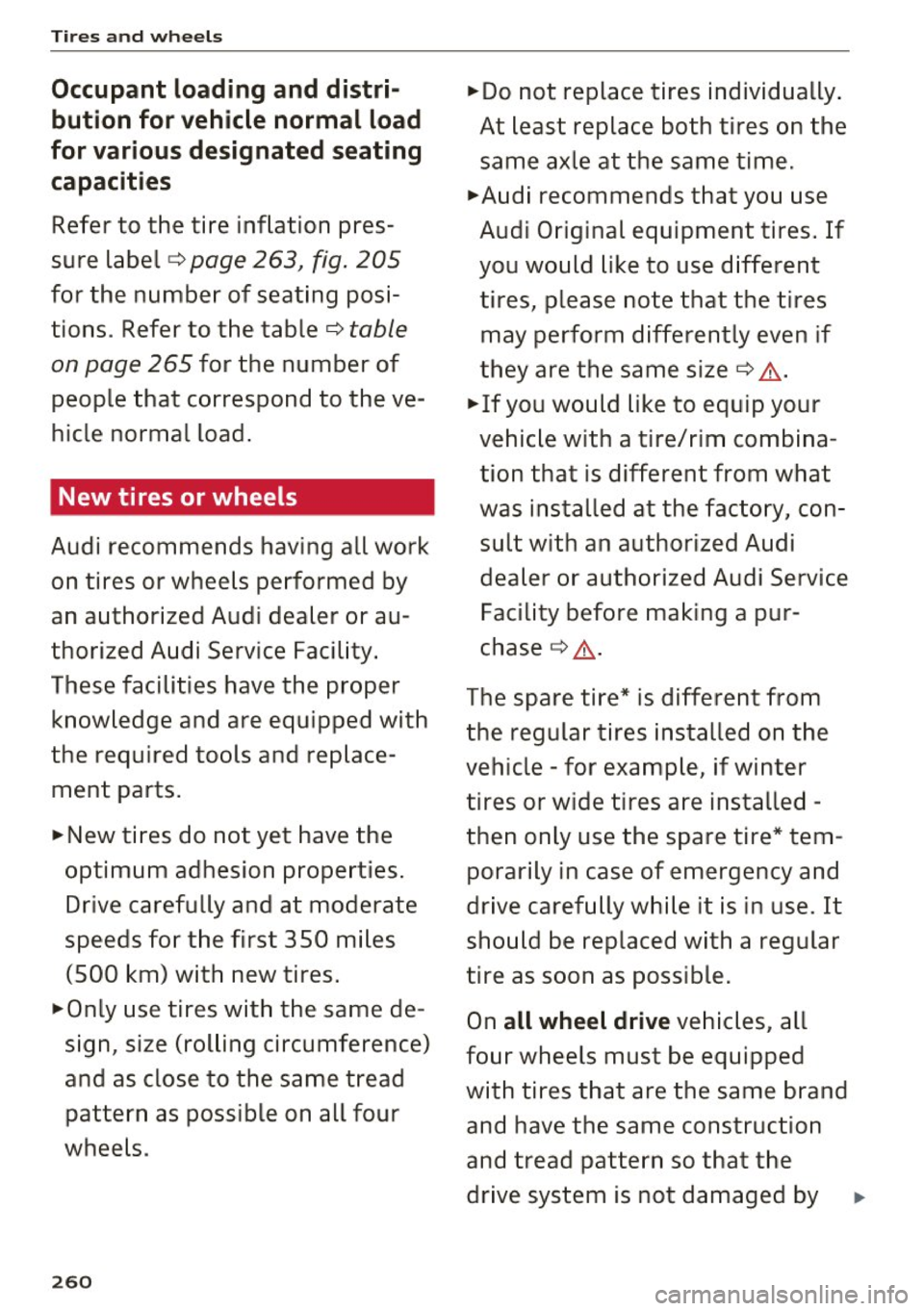
Tires a nd wh eels
Occupant loading and distri
bution for vehicle normal load
for various designated seating
capacit ies
Refer to the tire inflation pres
sure label¢
page 263, fig . 205
for the number of seating posi
tions . Refer to the table¢
table
on page 265
for the number of
people that correspond to the ve
hicle normal load .
New tires or wheels
Audi recommends having all work
on tires or wheels performed by
an authorized Audi dealer or au
thorized Audi Service Facility .
These facilities have the proper
knowledge and are equipped with
the required tools and replace
ment parts.
.,. New tires do not yet have the
optimum adhesion properties .
Drive carefully and at moderate
speeds for the first 350 miles (500 km) with new tires .
.,. Only use tires with the same de
sign, size (rolling circumference)
and as close to the same tread pattern as poss ible on all four
wheels .
260
.,.Do not replace tires individually .
At least replace both tires on the
same axle at the same time.
.,. Audi recommends that you use
Audi Original equipment tires . If
you would like to use d ifferent
tires, please note that the tires may perform differently even if
they are the same size ¢
,&.
.,. If you would like to equip your
vehicle with a tire/rim combina
t ion that is different from what
was installed at the factory, con
sult with an authorized Audi dealer or authorized Audi Service
F acility before making a pur
chase ¢&, .
The spare tire* is different from
the regular tires installed on the
vehicle -for example, if winter
tires or wide tires are installed -
then only use the spare tire* tem
porarily in case of emergency and
drive carefully while it is in use. It
should be replaced with a regular
tire as soon as possible.
On
all wheel drive vehicles, all
four wheels must be equipped
with tires that are the same brand and have the same construction
and tread pattern so tha t the
drive system is not damaged by .,.
Page 263 of 328
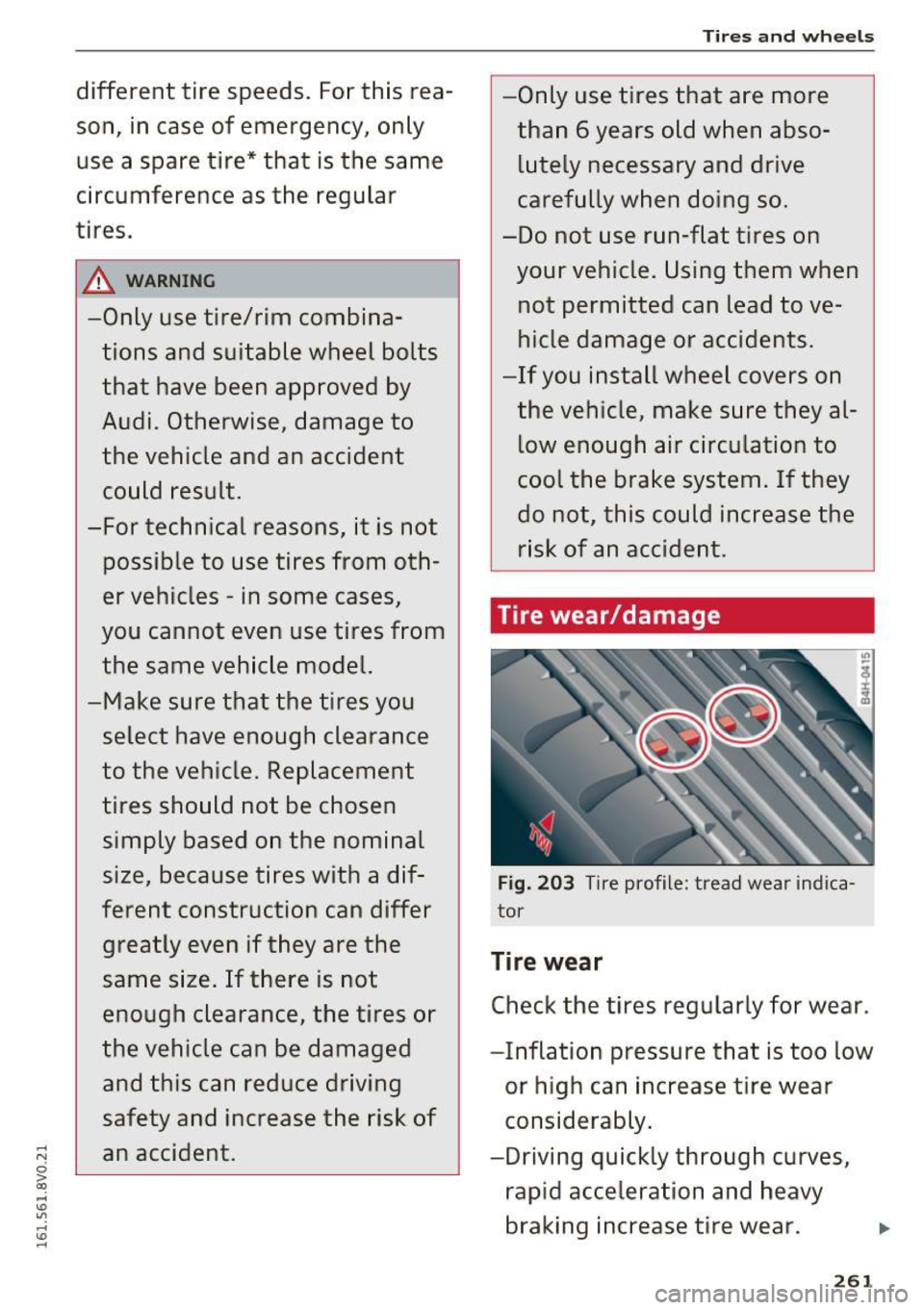
different tire speeds. For this reason, in case of emergency, only
use a spare tire* that is the same
circumference as the regular
tires.
&_ WARNING -
-Only use tire/rim combina tions and suitable wheel bolts
that have been approved by
Audi. Otherwise, damage to
the vehicle and an accident could result.
-For technical reasons, it is not possible to use tires from oth
er vehicles - in some cases,
you cannot even use tires from
the same vehicle model.
-Make sure that the tires you
select have enough clearance
to the vehicle . Replacement
tires should not be chosen
simply based on the nominal
size, because tires with a dif
ferent construction can differ
greatly even if they are the
same size. If there is not
enough clearance, the tires or
the vehicle can be damaged and this can reduce driving
safety and increase the risk of
an accident.
Tires and wheels
-Only use tires that are more
than 6 years old when abso lutely necessary and drive
carefully when doing so.
-Do not use run-flat tires on
your vehicle. Using them when
not permitted can lead to ve
hicle damage or accidents.
-If you install wheel covers on the vehicle, make sure they allow enough air circulation to
cool the brake system. If they
do not, this could increase the
risk of an accident.
Tire wear/damage
Fig. 203 Tire profile: tread wear indica
tor
Tire wear
Check the tires regularly for wear .
- Inflation pressure that is too low
or high can increase tire wear
considerably.
-Driving quickly through curves, rapid acceleration and heavy
braking increase tire wear. ..
261
Page 264 of 328
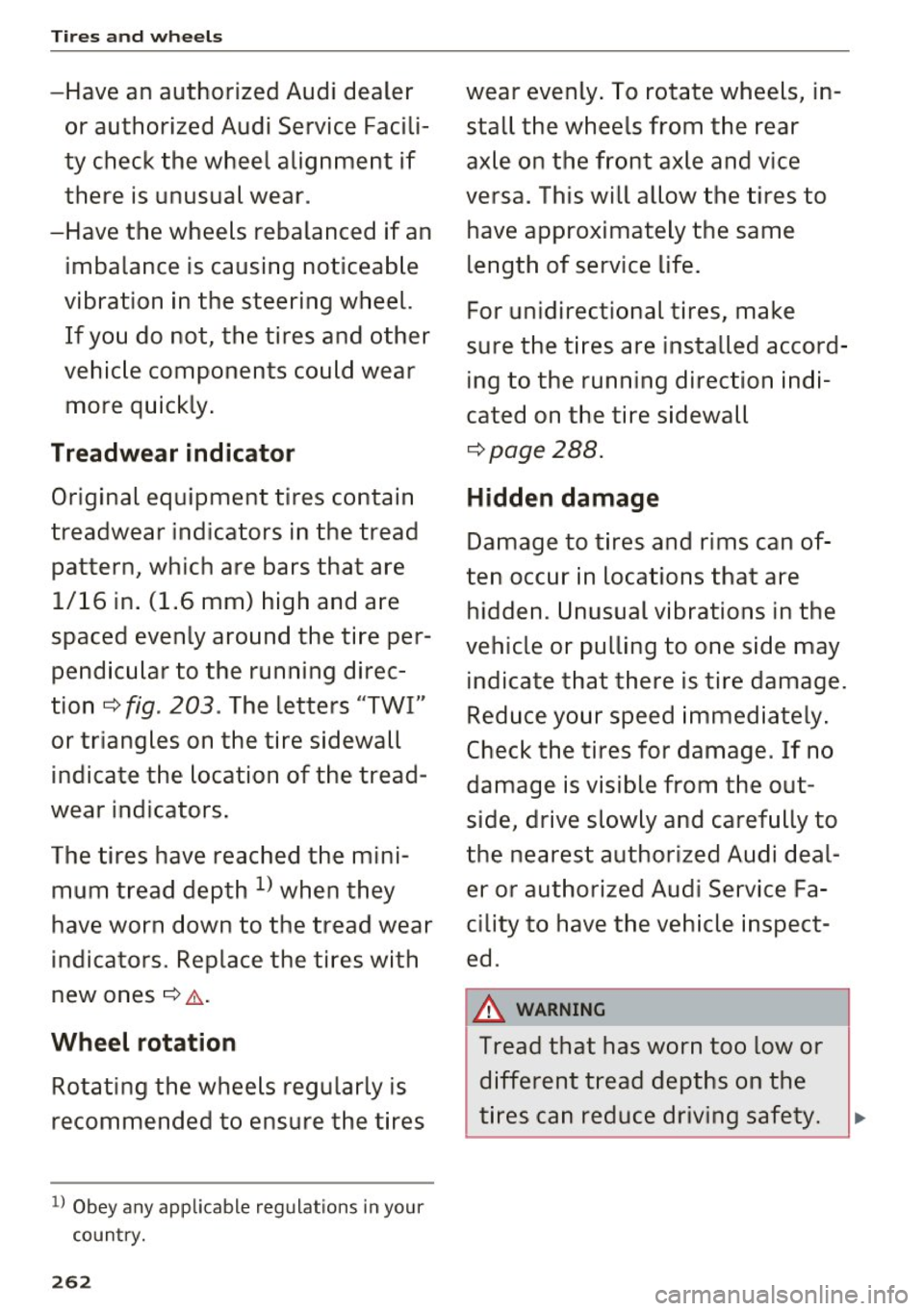
Tires and wheels
-Have an authorized Audi dealer or authorized Audi Service Facili
ty check the wheel alignment if
there is unusual wear .
-Have the wheels rebalanced if an imbalance is causing noticeable
vibration in the steering wheel. If you do not, the tires and other
vehicle components could wear more quickly.
Treadwear indicator
Original equipment tires contain
treadwear indicators in the tread pattern, which are bars that are 1/16 in. (1.6 mm) high and are
spaced evenly around the tire per
pendicular to the running direc
tion
¢ fig . 203 . The letters "TWI"
or triangles on the tire sidewall indicate the location of the tread
wear indicators.
The tires have reached the mini mum tread depth
l) when they
have worn down to the tread wear
indicators. Replace the tires with
new ones
¢ ..&. .
Wheel rotation
Rotating the wheels regularly is
recommended to ensure the tires
1> Obey any applicable regulations in your
country.
262
wear evenly. To rotate wheels, in
stall the wheels from the rear
axle on the front axle and vice
versa . This will allow the tires to
have approximately the same
length of service life.
For unidirectional tires, make
sure the tires are installed accord
ing to the running direction indi
cated on the tire sidewall
¢page 288.
Hidden damage
Damage to tires and rims can of
ten occur in locations that are hidden . Unusual vibrations in the
vehicle or pulling to one side may indicate that there is tire damage.
Reduce your speed immediately.
Check the tires for damage . If no
damage is visible from the out
side, drive slowly and carefully to
the nearest authorized Audi deal
er or authorized Audi Service Fa
cility to have the vehicle inspect
ed .
.&_ WARNING
Tread that has worn too low or
different tread depths on the
tires can reduce driving safety. ,..
Page 265 of 328
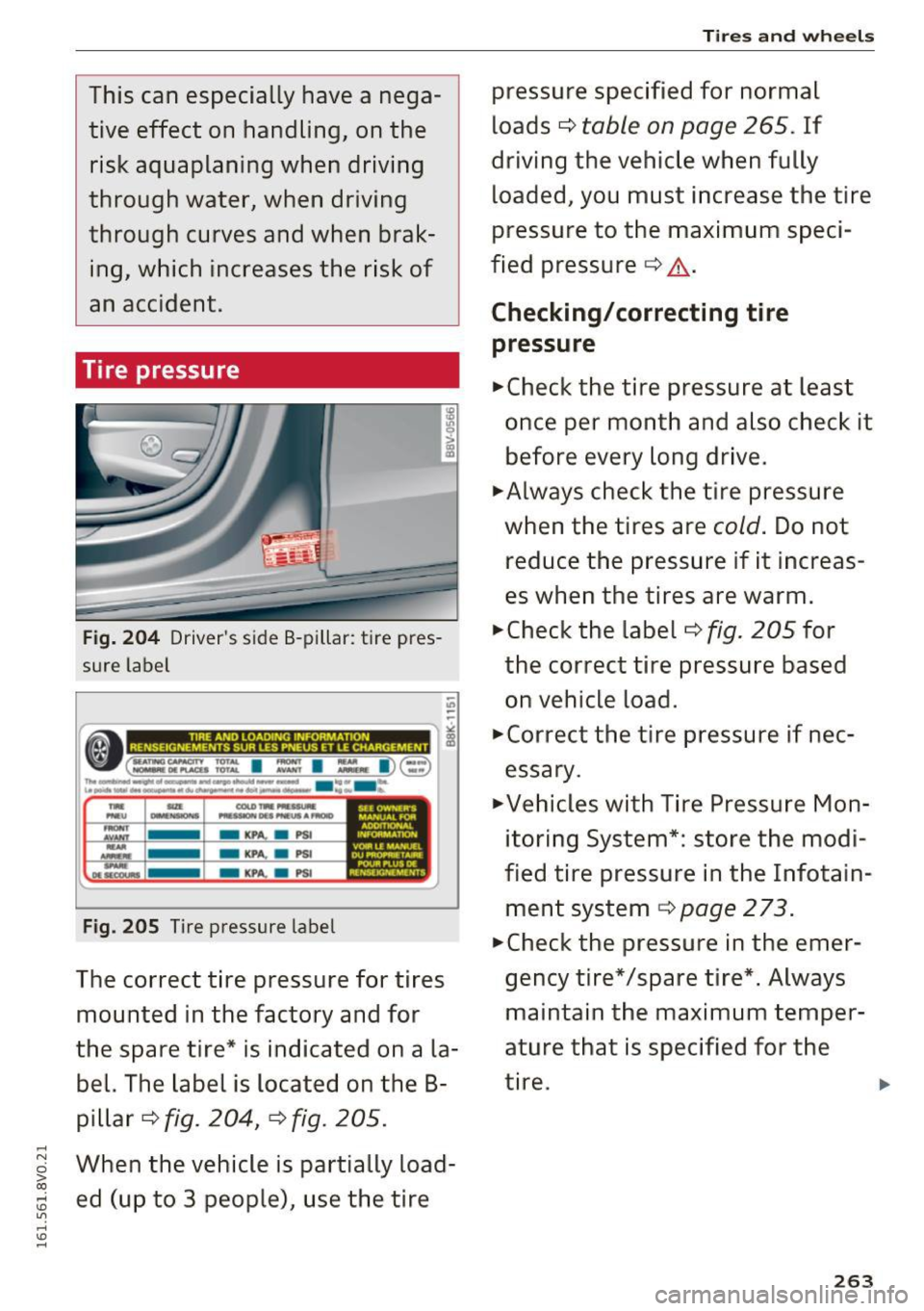
,...,
This can especially have a nega
tive effect on handling, on the risk aquaplaning when driving
through water, when driving
through curve s and when brak
ing, which increases the risk of
an accident.
Tire pressure
Fig. 204 Driver's side B -p ill ar: tire pres
su re lab el
-"' -,--------------- -
• ===========
= i (:=:=a : I =:: I :.. I) (':: ~) n,.......,.._,.,.. ......... _.__......, _ _.., .... _ ... l ................... . __.......... .......... ..._ .. .,,, ..
Fig. 205 Tire pressure label
The correct tire pressure for tires
mounted in the factory and for
the spare tire* is indicated on a la bel. The label is located on the B
pillar ¢
fig. 204, ¢ fig. 205.
g When the vehicle is partially load-
oo
~ ed (up to 3 peop le), use the tire Ln ,...,
"' ....
Tires and wheels
pressure specified for normal
loads¢
table on page 265 . If
driving the vehicle when fully loaded, you must increase the t ire
pressure to the maximum speci
fied pressure ¢.&, .
Checking/correcting tire
pressure
.,..Check the tire pressure at least
once per month and also check it before every long drive .
.,..Always check the tire pressure
when the tires are
cold . Do not
reduce the pressure if it increas
es when the tires are warm .
.,..Check the label ¢
fig. 205 for
the correct tire pressure based on vehicle load.
.,..Correct the tire pressure if nec
essary.
.,..Vehicles with Tire Pressure Mon
itoring System*: store the modi
fied tire pressure in the Infotain
ment system ~
page 273.
.,..Check the pressure in the emer
gency tire* /spare t ire* . Always
maintain the maximum temper
ature that is specified for the
tire. .,.
263
Page 266 of 328
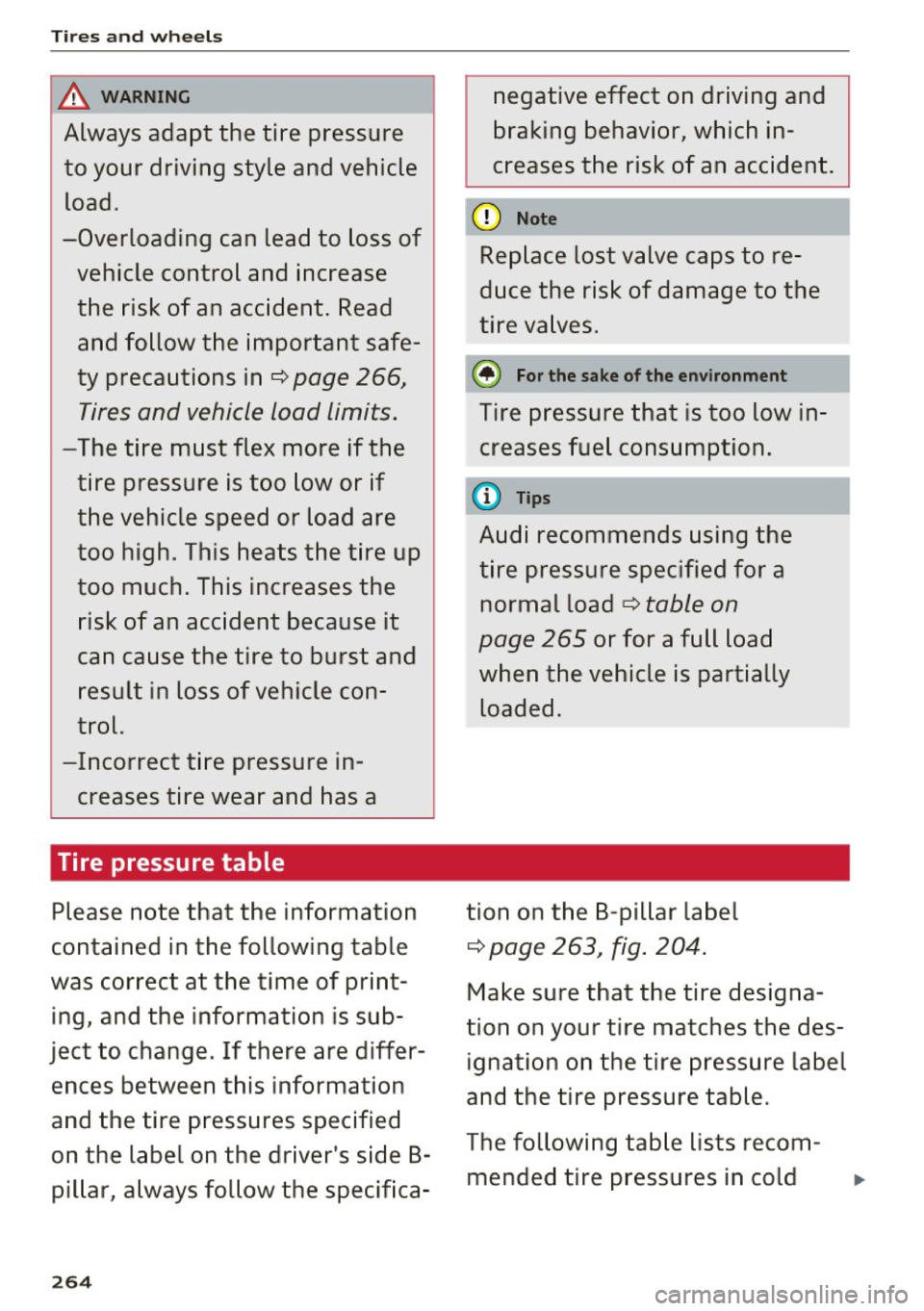
Tires and wheels
A WARNING
Always adapt the tire pressure
to your driving style and vehicle load.
-Overloading can lead to loss of vehicle control and increase
the risk of an accident. Read and follow the important safe
ty precautions inc:::> page 266,
Tires and vehicle load limits.
-The tire must flex more if the
tire pressure is too low or if
the vehicle speed or load are
too high. This heats the tire up
too much. This increases the
risk of an accident because it
can cause the tire to burst and
result in loss of vehicle con
trol.
-Incorrect tire pressure in creases tire wear and has a
Tire pressure table
Please note that the information
contained in the following table
was correct at the time of print ing, and the information is sub
ject to change . If there are differ
ences between this information
and the tire pressures specified
on the label on the driver's side 8- pillar, always follow the specifica-
264
negative effect on driving and
braking behavior, which in
creases the risk of an accident.
(D Note
Replace lost valve caps to re
duce the risk of damage to the
tire valves.
@ For the sake of the environment
Tire pressure that is too low in
creases fuel consumption.
(D Tips
Audi recommends using the
tire pressure specified for a normal load c:::>
table on
page 265
or for a full load
when the vehicle is partially
loaded.
tion on the 8-pillar label c:::>
page 263, fig. 204.
Make sure that the tire designa
tion on your tire matches the des ignation on the tire pressure label
and the tire pressure table.
The following table lists recom- mended tire pressures in cold ..
Page 267 of 328
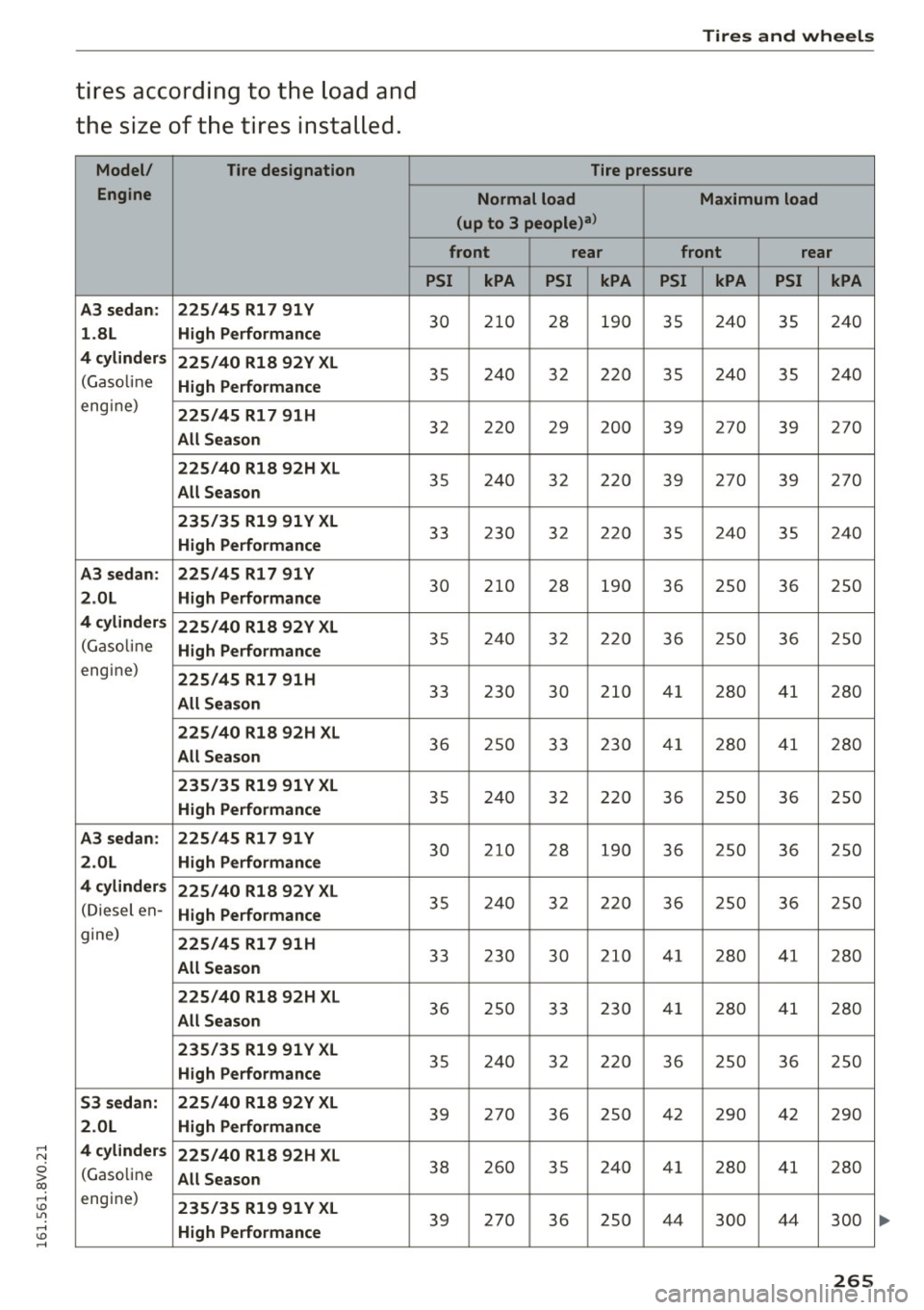
,....,
N
0 > co ,....,
th e s ize of the tire s installed .
Model/ Tire designation
Engine
A3 sedan : 225/45 Rl 7 91 Y
l .8L High Performance
4 cyl inders
225/40 Rl8 92Y XL
(G aso line High Performance
eng ine) 225 /45 Rl 7 91H
All Season
225 /40 Rl8 92H XL
All Season
235/35 Rl9 91 Y XL
High Performance
A3 sedan: 225 /45 Rl 7 91 Y
2 .0L High Performance
4 cylinders 225/40 Rl8 92Y XL
(G aso line High Performance
eng ine) 225 /45 Rl7 91H
All Season
225 /40 Rl8 92H XL
All Sea son
235/35 Rl9 91 Y XL
High Performance
A3 sedan: 225 /45 Rl 7 91 Y
2 .0L High Performance
4 cylinder s
225/40 Rl8 92Y XL
(D iesel en-High Performance
gine) 225/45 Rl 7 91H
All Season
225 /40 Rl8 92H XL
All Sea son
235/35 Rl9 91 Y XL
High Performance
53 sedan: 225 /40 Rl8 92Y XL
2.0L High Performance
4 cylinder s
225 /40 Rl8 92H XL
(Gaso line All Season
engine) 235/35 Rl9 91 Y XL
High Performance
Tires and wheels
Tire pressure
Normal load Maximum load
(up to 3 people)
3>
front rear front rear
PSI kPA PSI kPA PSI kPA PSI kPA
30 210 28 190 3 5 240 35 24 0
35 240 32 220 35 240 35 240
32 220 29 200 39 270
39 270
3 5 2 40 32 22 0 39 270 39 270
33 230 32 220
35 240
35 240
30 210 28 190 36 250 36 250
35 240 32 220 36 250 36 250
33 230 30 210 41
280 41
280
3 6 2 50 33 230 41 280 4 1 280
35 240 32 220
36 250
36 250
30 210 28 190 36 250 36 250
3 5 240 32 22 0 36 2 50 36 250
33 230
30 210 41 280 41 280
36 250 33 230 4 1 28 0 41 280
35 240 32 220 36 250 36 250
39 270
36 250 42
290 42
290
3 8 260 35 240 41 280 4 1 280
39 270
36 250 44 300 44
300
265
Page 268 of 328
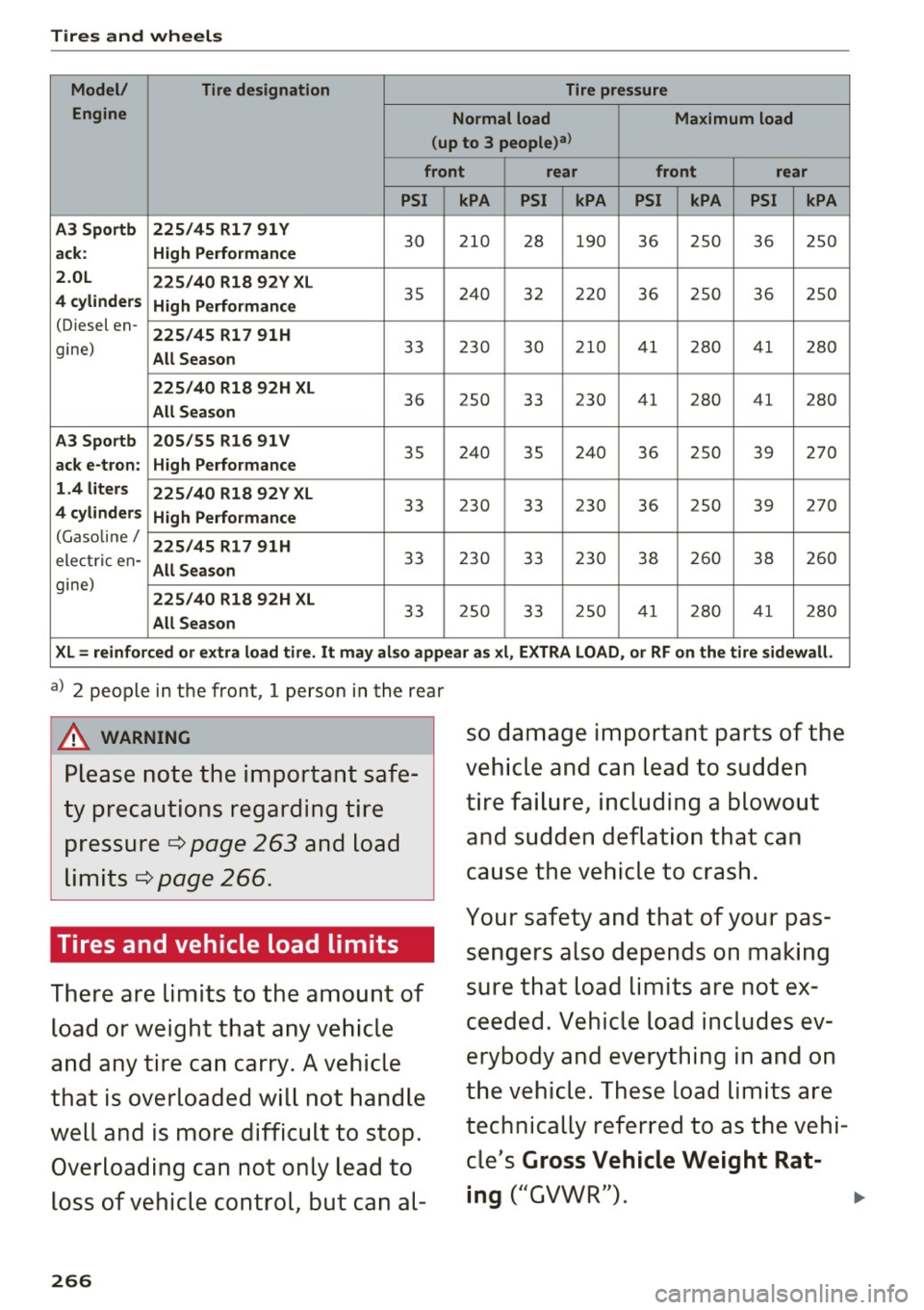
Tires and wheels Model/ Tire designation
Tire pressure
Engine Normal load
Maximum load
(up to 3 people)a>
front rear front rear
PSI kPA PSI kPA PSI kPA PSI kPA
A3 Sportb 225/45 Rl 7 91 Y ack: High Performance
30 210 28 190 36 250 36 250
2.0L
225/40 Rl8 92Y XL
4 cylinders High Performance
35 240 32 220 36 250 36 250
(Diesel en-
225/45 Rl7 91H
gine) All Season
33 230 30
210 41 280 41 280
225/40 Rl8 92H XL
All Season
36 250 33 230 41
280 41
280
A3 Sportb 205/55 Rl6 91 V
ack e-tron: High Performance
35 240 35 240 36 250 39 270
1.4 liters
225/40 Rl8 92Y XL
4 cylinders High Performance
33 230
33 230
36 250 39 270
(Gasoline/
225/45 Rl 7 91H
electric en- All Season
33 230 33 230 38 260 38 260
gine)
225/40 Rl8 92H XL
All Season
33 250 33 250 41 280 41 280
XL= reinforced or extra load tire. It may also appear as xi, EXTRA LOAD, or RF on the tire sidewall.
a) 2 people in the front, 1 person in the rear
A WARNING
Please note the important safe
ty precautions regarding tire pressure ¢
page 263 and load
limits ¢
page 266.
Tires and vehicle load limits
There are limits to the amount of
load or weight that any vehicle
and any tire can carry. A vehicle
that is overloaded will not handle
well and is more difficult to stop. Overloading can not only lead to
loss of vehicle control, but can al-
266
so damage important parts of the
vehicle and can lead to sudden
tire failure, including a blowout
and sudden deflation that can
cause the vehicle to crash.
Your safety and that of your pas sengers also depends on making
sure that load limits are not ex
ceeded. Vehicle load includes ev
erybody and everything in and on
the vehicle. These load limits are
technically referred to as the vehi cle's
Gross Vehicle Weight Rat-
ing
("GVWR"). ..,
Page 269 of 328
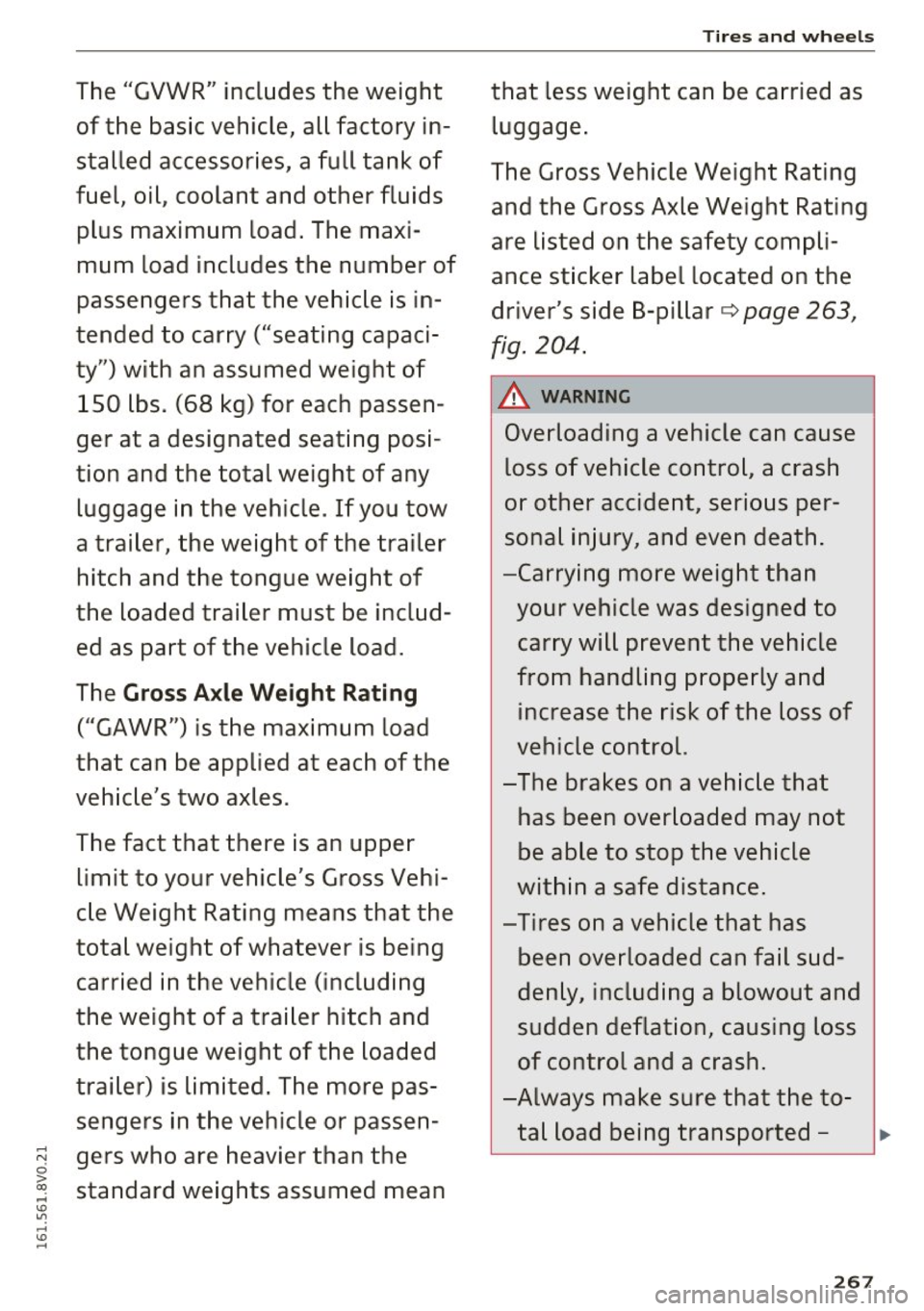
The "GVWR" includes the weight
of the basic vehicle, all factory installed accessories, a full tank of
fuel, oil, coolant and other fluids plus maximum load. The maxi
mum load includes the number of
passengers that the vehicle is in
tended to carry ("seating capaci
ty") with an assumed weight of 150 lbs. (68 kg) for each passen
ger at a designated seating posi
tion and the total weight of any luggage in the vehicle . If you tow
a trailer, the weight of the trailer
hitch and the tongue weight of
the loaded trailer must be includ
ed as part of the vehicle load.
The
Gross Axle Weight Rating
("GAWR") is the maximum load
that can be applied at each of the
vehicle's two axles.
The fact that there is an upper limit to your vehicle's Gross Vehi
cle Weight Rating means that the
total weight of whatever is being carried in the vehicle (including
the weight of a trailer hitch and
the tongue weight of the loaded
trailer) is limited. The more pas sengers in the vehicle or passen
gers who are heavier than the
standard weights assumed mean
Tires and wheels
that less weight can be carried as luggage.
The Gross Vehicle Weight Rating
and the Gross Axle Weight Rating
are listed on the safety compli
ance sticker label located on the driver's side B-pillar
¢ page 263,
fig. 204.
A WARNING
Overloading a vehicle can cause
loss of vehicle control, a crash
or other accident, serious per
sonal injury, and even death.
-Carrying more weight than your vehicle was designed to
carry will prevent the vehicle
from handling properly and increase the risk of the loss of
vehicle control.
-The brakes on a vehicle that
has been overloaded may not
be able to stop the vehicle
within a safe distance.
-Tires on a vehicle that has been overloaded can fail sud
denly, including a blowout and
sudden deflation, causing loss
of control and a crash.
-Always make sure that the to- tal load being transported -,..
267
Page 270 of 328
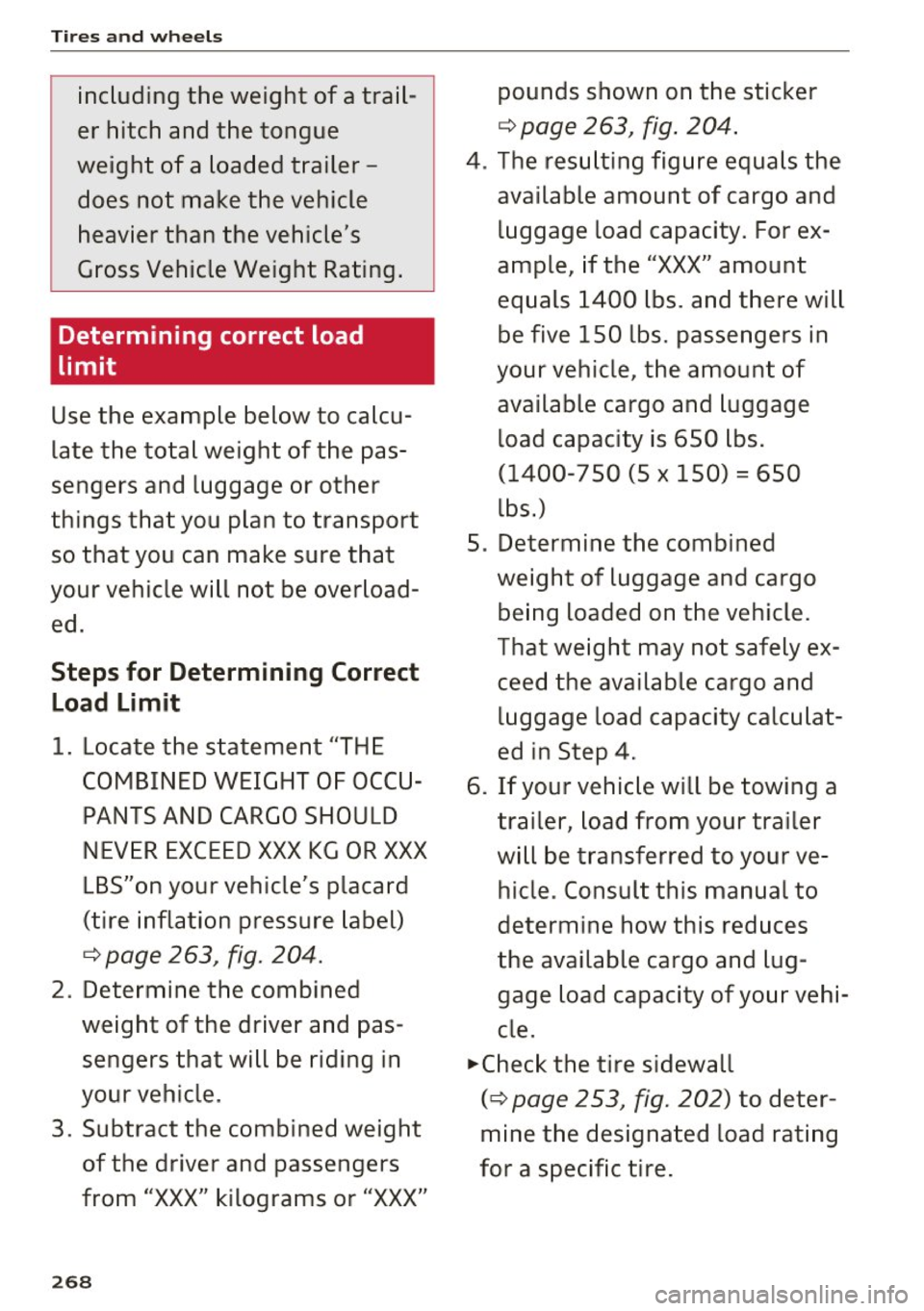
Tires and wheels
including the weight of a trail
er hitch and the tongue
weight of a loaded trailer does not make the vehicle
heavier than the vehicle's
Gross Vehicle Weight Rating.
Determining correct load
limit
Use the example below to calcu
late the total weight of the pas
sengers and luggage or other
things that you plan to transport
so that you can make sure that
your vehicle will not be overload ed.
Steps for Determining Correct Load Limit
1. Locate the statement "THE
COMBINED WEIGHT OF OCCU
PANTS AND CARGO SHOULD
NEVER EXCEED XXX KG OR XXX
LBS"on your vehicle's placard
(tire inflation pressure label)
¢ page 263, fig. 204.
2. Determine the combined
weight of the driver and pas
sengers that will be riding in
your vehicle.
3 . Subtract the combined weight
of the driver and passengers
from
"XXX" kilograms or "XXX"
268
pounds shown on the sticker
¢ page 263, fig. 204.
4 . The resulting figure equals the
available amount of cargo and
luggage load capacity. For ex
ample, if the
"XXX" amount
equals
1400 lbs . and there will
be five
150 lbs. passengers in
your vehicle, the amount of available cargo and luggage
load capacity is
650 lbs .
(1400-750 (5 X 150) = 650
lbs.)
5. Determine the combined
weight of luggage and cargo
being loaded on the vehicle.
Tha t weight may not safely ex
ceed the available cargo and luggage load capacity calculat
ed in Step 4.
6. If your vehicle will be towing a
trailer, load from your trailer
will be transferred to your ve hicle . Consult this manual to
determine how this reduces
the available cargo and lug
gage load capacity of your vehi
cle.
~check the tire sidewall
(¢ page 253, fig. 202) to deter
mine the designated load rating
for a specific tire.